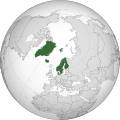Comparison of the Nordic countries
This article needs additional citations for verification. (February 2018) |
This article is a comparison of the Nordic countries.
Geography[]
| Country / dependency | Total area (km2) | Land (km2)[a] | Ice cap and glaciers (km2) |
Water (km2) | Ref |
|---|---|---|---|---|---|
| Denmark[b] | 43,561 | 42,890 | 0 | 671 | [1] |
| Finland[c] | 338,145 | 303,815 | 0 | 34,330 | |
| Iceland | 103,492 | 89,717 | 11,389 | 2,386 | |
| Norway[d] | 323,771 | 302,630 | 2790 | 18,351 | |
| Sweden | 447,435 | 407,161 | 314 | 39,960 | |
| Bouvet Island (NO) | 49 | 3 | 46 | 0 | |
| Faroe Islands (DK) | 1,396 | 1,387 | 0 | 9 | |
| Greenland (DK) | 2,166,086 | 410,449 | 1,755,637 | 0 | |
| Jan Mayen (NO) | 373 | 259 | 114 | 0 | |
| Peter I Island (NO) | 154 | 8 | 146 | 0 | |
| Queen Maud Land (NO)[e] | 2,700,000 | 0 | 2,700,000 | 0 | |
| Svalbard (NO) | 61,022 | 24,520 | 36,502 | 0 | |
| Åland (FI) | 1,580 | 1,553 | 0 | 27 |
Demographics[]
| Country | Population | Density (per km2) | Immigration (%) |
|---|---|---|---|
| Denmark | 5,771,672 | 133.9 | 7.90 |
| Finland | 5,622,534 | 16.6 | 5.53 |
| Iceland | 340,028 | 3.3 | 6.65 |
| Norway | 5,501,167 | 17.0 | 14.10 |
| Sweden | 10,129,869 | 22.5 | 14.98 |
| Bouvet Island (NO) | 0 | 0 | 0 |
| Faroe Islands (DK) | 50,322 | 35.2 | NA |
| Greenland (DK) | 56,483 | 0.028 | NA |
| Jan Mayen (NO) | 0 | 0 | 0 |
| Peter I Island (NO) | 0 | 0 | 0 |
| Queen Maud Land (NO) | 0 | 0 | 0 |
| Svalbard (NO) | 2,667 | 0.043 | NA |
| Åland Islands (FI) | 29,013 | 18.36 | NA |
Source: United Nations Department of Economic and Social Affairs: Population Division (October 2019).
Politics[]
Government[]
| Country | Political systems | Power source | Power structure |
|---|---|---|---|
| Denmark | Parliamentary system | Constitutional monarchy | Unitary state |
| Finland | Constitutional republic | ||
| Iceland | |||
| Norway | Constitutional monarchy | ||
| Sweden |
International organisation membership[]
| Country | Council of Europe | Nordic Council | ECHR | European Union | EEA | EFTA | NATO | OECDa | United Nations | WTO |
|---|---|---|---|---|---|---|---|---|---|---|
| Denmark | 5 May 1949 | Yes | Yes | 1973 | Yes | No | 4 April 1949 | 30 May 1961 | 24 October 1945 | Yes |
| Finland | 5 May 1989 | Yes | Yes | 1995 | Yes | No | No | 20 January 1969 | 14 December 1955 | Yes |
| Iceland | 7 March 1950 | Yes | Yes | No | Yes | Yes | 4 April 1949 | 5 June 1961 | 19 November 1946 | Yes |
| Norway | 5 May 1949 | Yes | Yes | No | Yes | Yes | 4 April 1949 | 29 May 1973 | 27 November 1945 | Yes |
| Sweden | 5 May 1949 | Yes | Yes | 1995 | Yes | No | No | 28 September 1961 | 19 November 1946 | Yes |
a Denmark, Norway and Sweden were among the founders of the predecessor of the OECD, the OEEC, in 1948
Economy[]
| Country | GDP total (PPP) | GDP per capita (PPP) | GDP total (nominal) | GDP per capita (nominal) | Gini | HDI |
|---|---|---|---|---|---|---|
| Denmark | $325.556 billion | $56,412 | $362.150 billion | $62,041 | 28.1 | 0.929 |
| Finland | $252.753 billion | $44,958 | $282.010 billion | $50,879 | 25.9 | 0.920 |
| Iceland | $26.674 billion | $80,247 | $20.284 billion | $79,270 | 24.0 | 0.935 |
| Norway | $441.439 billion | $78,285 | $448.460 billion | $82,773 | 22.3 | 0.953 |
| Sweden | $554.659 billion | $54,759 | $563.240 billion | $54,135 | 25.4 | 0.933 |
Source: (IMF) International Monetary Fund 2018
Telecommunication[]
| Country/Territory | Internet TLD | ISO 3166 code | Calling code |
|---|---|---|---|
| Denmark | .dk | DK | +45 |
| Finland | .fi | FI | +358 |
| Iceland | .is | IS | +354 |
| Norway | .no | NO | +47 |
| Sweden | .se | SE | +46 |
| Bouvet Island | .bv | BV | |
| Faroe Islands | .fo | FO | +298 |
| Greenland | .gl | GL | +299 |
| Queen Maud Land and Peter I Island | .aq | AQ | |
| Svalbard and Jan Mayen | .sj | SJ | +47 79 |
| Åland Islands | .ax | AX | +358 18 |
See also[]
- Comparison of the Baltic states
- Comparison of the Benelux countries
References[]
- ^ "Nordic Statistical Yearbook 2014" (PDF). www.norden.org/facts. Nordic Council. Retrieved 2014-11-22.
Categories:
- Nordic countries
